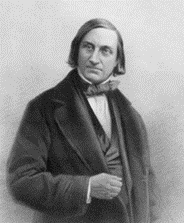Edward Forbes
1815-1854
A Manx naturalist. In 1846, he proposed that the distributions of mountainous plants and animals had been compressed downslope, and some oceanic islands connected to the mainland, during the recent ice age. This mechanism, which was the first natural explanation to explain the distributions of the same species on now-isolated islands and mountain tops, was discovered independently by Charles Darwin, who credited Forbes with the idea. He also incorrectly deduced, the so-called azoic hypothesis, that life under the sea would decline to the point that no life forms could exist below a certain depth. As a child, Forbes was very interested in collecting insects, shells, minerals, fossils, and plants. Due to poor health, he was unable to attend school from his 5th through his 11th years. In 1828, he started attending the Athole House Academy in Douglas. In June 1831, Forbes moved to London to study drawing but was not admitted by the Royal Academy. However, having given up on art as a profession, he trained privately and moved back to Douglas. In later years, Forbes used his artistic abilities to create humorous drawings for his publications. In November 1832, Forbes matriculated as a medical student in the University of Edinburgh attending the lectures of Robert Jameson and Robert Knox while also being active in student societies. In 1836, Forbes abandoned his medical studies and moved to Paris, where he attended the lectures at the Jardin des Plantes on natural history, comparative anatomy, geology and mineralogy. In April 1837, Forbes travelled to Algiers to gather material for a paper on land and freshwater Mollusca. He remained in Edinburgh, paid for by his father. On 17 April 1841, Forbes and naturalist William Thompson, joined at Malta HM surveying ship Beacon, to which he had been appointed naturalist by her commander Captain Thomas Graves (1802–1856). From April 1841 until October 1842, Forbes investigated the botany, zoology and geology of the Mediterranean region. In 1843, Forbes presented a Report on the Mollusca and Radiata of the Aegean Sea, to the British Association. In the report, he discussed the influence of climate and of the nature and depth of the sea bottom upon marine life. He divided the Aegean region into eight biological zones. In his azoic hypothesis, Forbes stated that the sea regions below 300 fathom were entirely devoid of life. This hypothesis was disproved 25 years later. In 1842, financial pressures forced Forbes to take the curatorship of the museum of the Geological Society of London. In 1843, he also became a professor botany at King's College London. On 26 August 1848, Forbes married Emily Marianne Ashworth, the daughter of General Sir Charles Ashworth. Forbes theorized that the majority of British terrestrial animals and flowering plants migrated there over land bridges before, during and after the ice age. His theory was later discredited. In 1853 Forbes became President of the Geological Society of London. In 1854, he was appointed Professor of Natural History at the University of Edinburgh, a long-sought goal. During his later years, Forbes found more time in between lecturing and writing to order his stores of biological information. In the summer of 1854, Forbes lectured at Edinburgh and in September served as President of the geological section at the Liverpool meeting of the British Science Association. In November 1854, soon after the start of winter classes at Edinburgh, Forbes became ill. He died at Wardie Parish, near Edinburgh, on 18 November 1854.He was interred at the Dean Cemetery in Edinburgh.
